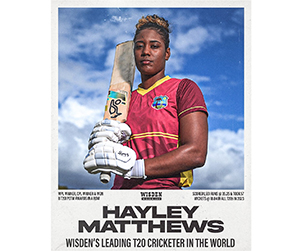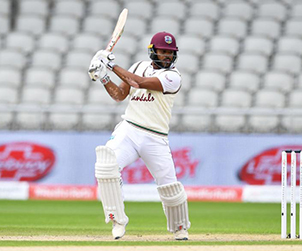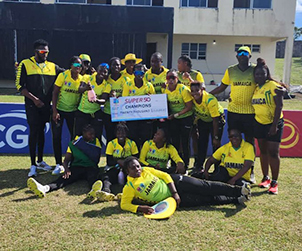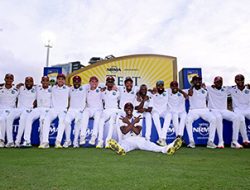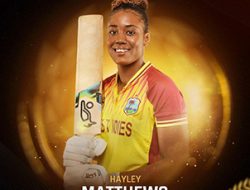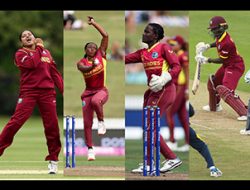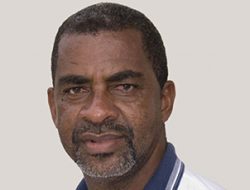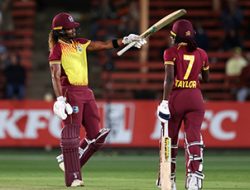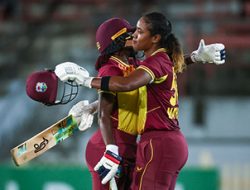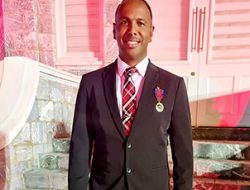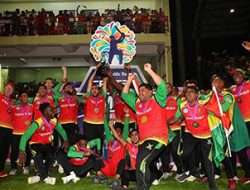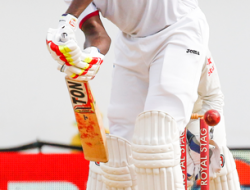What were Barbados wickets like when you played?
Quick, with more bounce than, say, in the UK, where I played a lot with Hampshire. There would be a light tinge of green on the pitch, rolled in to bind it.
In Australia, pitches were even bouncier.
Guyana and Trinidad weren’t bouncy pitches. Antigua was. Barbados was the quickest of the West Indies pitches when I played. The ball steepled more, which mean a lot of back-foot play.
Your second Test tour was the 1975-76 Test series against Australia, when West Indies lost 5-1? What did you learn from it?
It was a real eye-opener. The way the Australians played the game – verbals, bouncers, batsmen standing their ground until the umpire gave them out, which he often didn’t, sometimes even when it was pretty obvious that they were out… It was the sort of tour where either you crack and give up the game or you put your head down and say, no, this will not beat me.
What was the toughest thing about playing against Australia back then?
The Australians were seasoned professionals, hardcore players who didn’t give an inch, whereas a lot of us [West Indians] were on our first or second tours. We’d been in India the year before, playing on slow, low pitches. We had to grow up pretty quickly. The feeling was that this lashing we got would never happen to this group of players again.
How have Barbados wickets changed between then and now?
They’re much slower now. Some of them have been relaid, or the preparation is different. That hardness you used to see in the Caribbean has gone. Unfortunately, you haven’t really seen the batsmen making use of the slower pitches. That’s one of the main problems in West Indies cricket.
What made Barbados cricket special when you played?
In years gone by, when teams toured the West Indies, they wanted to play in Barbados because they got good practice for the Test series coming up. The pitch was good to bat on but also good for bowlers. And Barbados had a team that was good enough to take on any touring side.
Why did you prefer opening to middle order?
I wasn’t one for sitting around waiting. If I had to wait to bat, I would have been a bag of nerves. Not sure if I’d have made it. I don’t think I could have just sat there watching the others. I wanted to get in and get started. I didn’t have the patience. I’ve never been a great watcher of this great game anyway. Not even now. When I got out, I had to find something to do or somewhere to go.
How did you prepare for a big game?
I’d take my favourite bat, maybe one that I’d done some modifications to, put some extra rubbers on the handle, or [a grip] with more pimples to get a better grip. Then I’d sleep with it by the side of the bed because you didn’t want anyone to touch it. Before I went to bed, I’d play some shots in the mirror, start to think of the innings before the game begun. Gets you the feeling that you want to get the game started, get out there and be part of what’s happening. Then on the morning of the game you can’t wait to get out there.
What did you learn from Barry Richards and Roy Fredericks about opening?
Barry was very quiet. Roy was, too. Unfortunately, no one got to see the best of Barry. At the end of his career, it was obvious he’d got pretty bored, not being able to play international cricket.
Roy was a dashing player, would almost play a stroke at every ball he faced. He was very courageous. It didn’t matter who was bowling, how quick, he would challenge them. That was good to see.
I liked to think of myself as someone who was going to take the fight to the bowler rather than the fight come to you. Challenge what is happening in front of you.
Who was the better opener, Fredericks or Desmond Haynes?
Totally different players. I only played for a short while with Freddo. He was the experienced guy coming to the end of his career. I was the apprentice, just starting out. Freddo was an individual, Desmond more controlled in the middle. He showed a lot of courage. Didn’t flinch. Very committed. Both accomplished players, very different.
Why do you think you and Haynes had such a good opening partnership?
Desmond and I often shadowed each other. If things were going well for him, he took the lead. If it was my day, I pushed on while he dug in. Our communication was good. We’d chat well in between overs. Our running between the wickets got better the longer we batted together. Sometimes we didn’t even bother calling. We just knew when to run and when not to.
Sunil Gavaskar or Geoff Boycott, who did you admire most as an opening batsmen?
Difficult to choose. They were both very dogmatic in their approach. Sunil was more attacking. His strokeplay and technique was spot on.
A lot of people don’t appreciate Boycs, but I think he did a great job for England. Okay, England didn’t win many matches because of him, but you can say that often they didn’t lose a game because of how he played.
Why do you think Gavaskar was able to score against West Indies when most other batsmen of that time struggled?
When Sunil played back, he stayed leg side, didn’t move across his stumps, back and across. It was very difficult to play against those bowlers if you moved back and across. Most of them brought the ball back into you, with pace and bounce. It was only really Malcolm [Marshall] who swung the ball away. Also, Sunil was positive in the strokeplay. Allan Lamb did the same.
Why do you think West Indian batsmen of your era played fast short-pitched bowling so well?
Viv and Desmond did. I was a front-foot player, so you have to count me out of that. I didn’t play the short ball very well. It’s not a delivery that I enjoyed facing. It’s just that some have the game to play it better than others. In general, I don’t think people play it that well.
Did it have anything to do with the amount of beach cricket you guys played growing up?
Maybe, yes. The bowler would wait for the waves to come onto the sand and make it harder, and then pitch the ball short so it skidded at you a lot quicker. You had to learn how to play off the back foot. I learned to play on a 12-foot wide concrete strip between two houses. If you hit either house you were out, so you had to play straight.
Did your West Indies captains say much to you about tactics and strategy or just leave you to get on with it?
Clive Lloyd had a very good side. The bowlers had their own union and decided between them who would open the bowling, who would come on first- and second change. They would do the job according to how they wanted to do it, between them.
Clive didn’t restrain the batters from being as aggressive as they wanted to. Yes, at times it was the downfall of a few of us. More often than not, he allowed the players to approach the situation as they wanted to without being inhibited.
What was hardest to face, pace and bounce or swing and seam?
At the beginning it was the pace and bounce. I’d learned to play the swing reasonably well, so it didn’t trouble me that much. I would consider myself more a front-foot player.
What was the key to playing the swinging ball?
Watch the ball very carefully. Play much straighter. Get a lot closer to the ball and cut down the swing. Don’t stand back and wait for it to swing. Sometimes I would stand slightly outside the crease to do this. Patience would help here. When you went to strike the ball, you did it with purpose. Strokeplay should be purposeful. If you’re going to hit the ball, hit it. Hesitancy was the downfall of loads of us.
What’s the best way to learn about batting?
Watch someone who does it well. You can only get so far listening to someone tell you how to play this or that shot. Much better to watch someone playing it. The cut, for instance, was one of my trademark shots, but there are lots of batsmen who play it well, so watch a video clip of one of them. If you’re a coach, demonstrate, don’t just talk. It’s much easier if players see what to do for themselves.
Best advice you received?
Be positive. If you’re forceful, it’s the opposition that have to change their plan of attack.
How did you play the cut shot?
You rock back, make good contact, and come down on the ball as you strike it. If you flat-bat it, the ball will go in the air. Roll the bat face as you strike the ball. That way the ball will skid off the bat surface, past fielders.
Footwork is back and across, pivot on your back foot. Watch the video. You’ll see how it’s done.
Why do batsmen sometimes get into trouble playing the shot?
They don’t pick the right ball. If it’s short and wide, that makes it easier to execute the shot well. You can free your arms, extend the bat at full length and strike the ball really cleanly.
The ball doesn’t have to be that wide for you to play the square cut. You can back away, give yourself a bit of room. Stay balanced when you back away, though. If the ball is not too close to you, you might knock it back on to the stumps.
How important is balance?
Ideally you’re on the balls of your feet, just beneath your toes. It’s important to have a balanced stance, so you can move into position. Some people can plant their foot and then adjust quickly and rotate when they see where the ball is. But if you’re too flat-footed it’s difficult to move quickly forward or back.
Who taught you the most about batting?
My mentor was John Arlott. Many times I got invitations to his home in Hampshire. We would have lengthy conversations down in his cellar, about cricket, life in general, how to set yourself up in this great game, what you needed to do to be successful and play for a long period.
John lived in an old, converted, pub. He used to tell me not to be so attacking. When I was younger it was ingrained in you that you sometimes just couldn’t resist trying to hit every ball for four or six. There were times when it was your downfall. So we’d speak about knowing when to be aggressive and when not to.
Did playing on green English pitches help hone your defensive technique?
It helped all my techniques. You’d play on lots of different surfaces, on uncovered wickets, which I thought were unfair to the batsman. The bowler’s run-up was covered, so he’d have a dry spot to land on. Sometimes our bats had more mud on them than ball marks. And you had to score fast to set up a win inside three days. Those pitches made you think. Helped you develop the sort of technique that would bring you success when it was difficult.
What are young West Indies batsmen today missing?
They don’t have enough cricket behind them – first-class cricket, quality cricket. They come in without anyone in the team to tutor them, because everyone is of about the similar level of experience. It’s like they’re thrown into the deep end and either they swim or they sink. Makes it difficult for guys to speak to each other. I’m not sure that any one of them could give the other advice, because they’re all in the same boat.
What needs to be done to set things right?
Regional cricket has to be stronger. At the moment it’s exceptionally weak, so it’s not going to produce the players you’re looking for for international cricket. How I’m not certain, but something needs to happen. If it doesn’t happen, we’ll continue to be the way we are. It’s sad to see, but that’s the reality of it.
What’s the difference between how the champion West Indian teams you played in approached the game, compared to how today’s West Indian teams go about it?
I don’t see the intensity in players today. The drive to represent the West Indies. I could be wrong, but I don’t see it. To play in a Test match, in that arena, for the West Indies. That is the best, the thing you hope for as a cricketer. To see players with broad smiles after they’ve just lost a game. That’s not on. A big no-no. It’s like people are thinking, we’ve lost, never mind, on to the next one. A team can’t not manage to make 200 in either innings and then go about the place smiling. It’s like it’s no big thing to lose a match. Every game should be played like it’s a final. You win, then you move on.
How did the teams you played in respond to losing?
When we lost a match, some of the guys wouldn’t even want to go out for dinner, we’d order room service. You’d sit there and discuss the game. We’d think: yes, the opposition played well, but we had everything we needed to win that game, had it well in hand at one point, so what went wrong? We’d wonder where we lost our direction.
Did you really play better when you were limping or is that just a myth?
Definitely a myth. But it worked because people thought I did. I played with a chronic back injury for most of my career. I also perspired heavily when batting, which often gave me a stiff neck. Don’t know what I would have done without Dennis Waite [the West Indies physio]. He’d get me on the field, sometimes with cortisone injections, but that’s the sacrifice you make if you want to play.
What are you doing now?
I’m hoping to raise money for Gordon Greenidge Primary School in St James, Barbados. Two schools, joined together and moved to a new site. It was the Barbados government’s idea to name it after me. I’m also going to be a tour guide on England’s tour to the Caribbean next March. There’ll be two ODIs in Antigua and one in Barbados.

